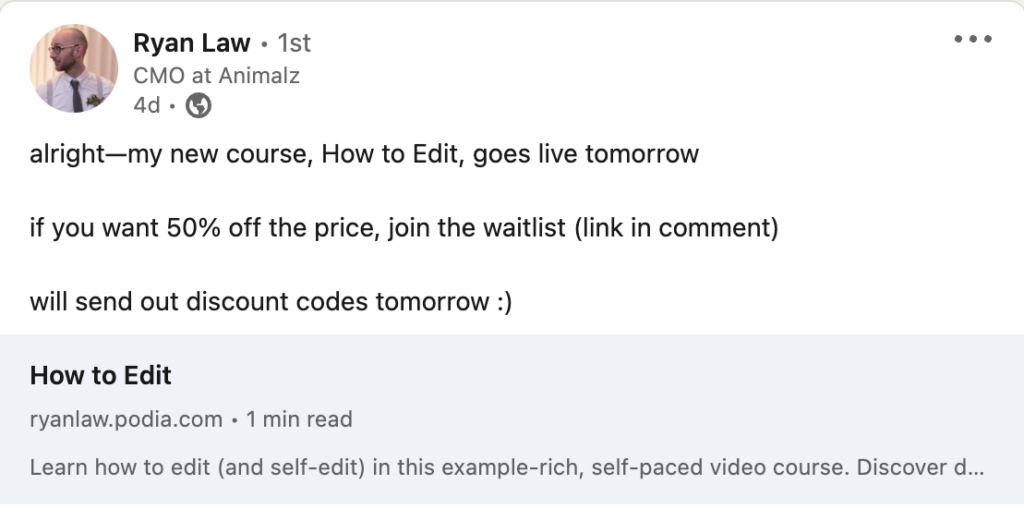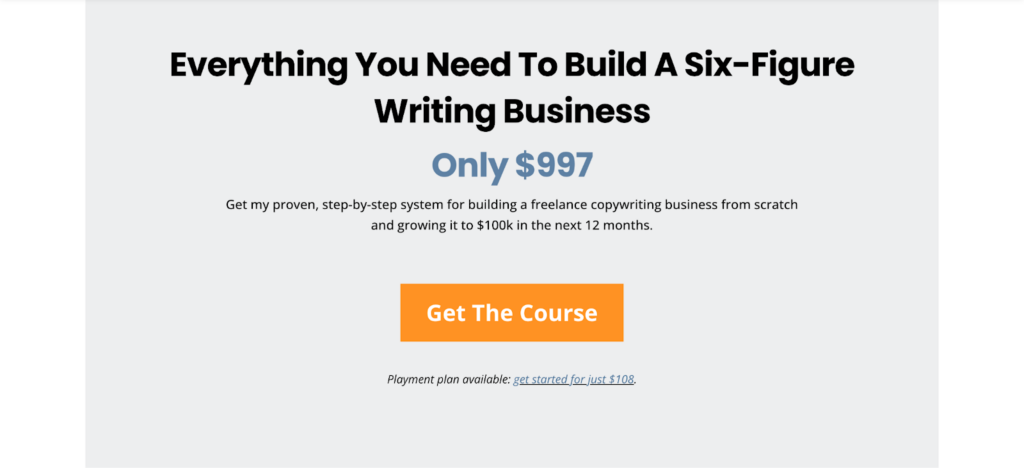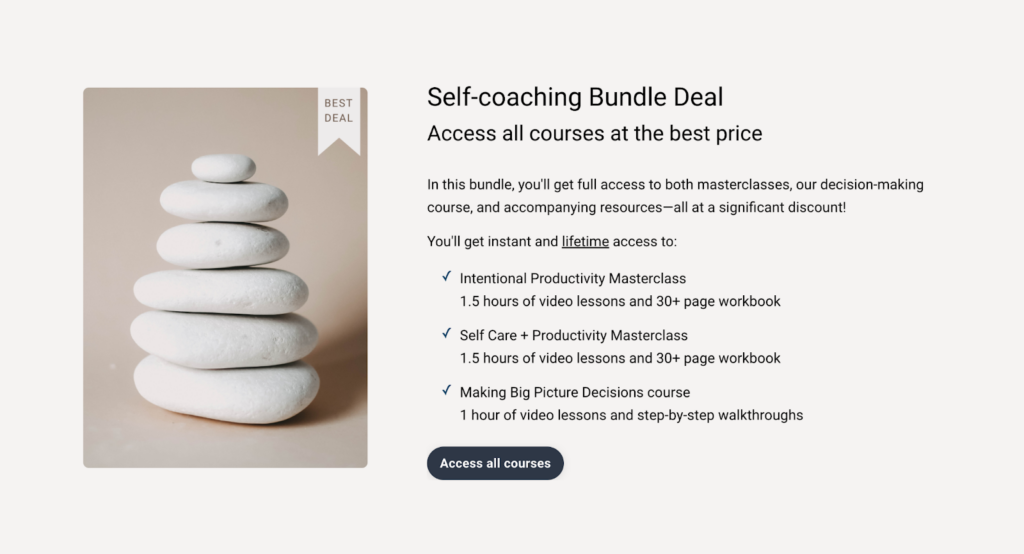Stressed about pricing your digital product? You’re not alone. Many creators, even those who have been at it for a long time, struggle with setting the ideal price for their digital products.
This is because there’s no one-size-fits-all approach to pricing. It depends on multiple factors like your digital product type, customers and the value you deliver to prospective customers.
In this article, we’ll discuss all the things you should consider when it’s time to determine how much to sell your digital products.
Skip ahead:
How to set the right price for your digital product
Pricing is never straightforward. But following these fundamental steps will make the process easier for you.
Find out how much your target audience is willing to pay
Knowing how much your audience is willing to pay helps you to set a price that matches their expectations. Say your audience expects to spend 100 USD on an ebook; selling yours for 300 USD puts your product out of the market. On the flip side, if they expect to spend 300 USD on an ebook, but you sell yours for 100 USD, they might think your ebook is low-quality and won’t buy it.
Read more: 21 Profitable Digital Products and Where to Sell Them
There are three steps to finding your audience’s pricing sweet spot.
Conduct a demographic survey
A demographic survey helps you gather information about your audience’s social characteristics — like their education and income levels, and occupations. This data helps you to gauge your audience’s spending power. For example, the higher your audience’s disposable income, the more likely they are to purchase high-end digital products.
Survey respondents might not be willing to share the exact numbers regarding their income — which is why you should only ask closed-ended demographic questions and provide options in ranges. Here’s an example:
How much do you earn every month?
- Less than $1,000
- $1,000 – $3,000
- $3,000 – $5,000
- More than $5,000
You can administer your demographic survey in person or create an online questionnaire using free form builders like Google Forms.
Analyze your audience’s pain point(s)
Focus on two things here:
- How badly your audience wants to solve the pain point.
- The ROI of solving the pain point
If the pain point is only a mild inconvenience, your audience might not want to pay a lot of money for a solution. However, if it is causing major losses, they will be willing to pay whatever it costs to resolve the problem.
Similar logic applies to ROI. If your audience gains a lot from solving the pain point, they’ll happily pay the highest price for a solution. But if solving it makes little or no difference in their lives, they won’t see a reason to purchase a highly expensive solution.
Listen to your audience discuss the pain point to know how they feel about it. Start by following conversations on social media with social listening tools like Mention. Then, take things a notch higher by scheduling one-on-one conversations with your target audience for direct feedback on the pain point.
Research your competitors
Find out what your competitors are charging to know what the predominant pricing in the market looks like.
Say they all charge 100 – 150 USD for a course; selling yours above that might discourage potential clients unless you can prove that your course is more valuable than what exists on the market. And if they offer discounts, it’s a sign to include a similar offering in your pricing strategy.
Competitor pricing research is a pretty straightforward process. Start by listing three to five creators selling similar digital products. Next, visit their websites or specific digital product landing pages to see how they price these products.
Look beyond the numbers; consider their overall product offering. Do they have high pricing but allow people to pay in instalments? Or offer digital product packages that help customers save money on purchases? These insights will help you understand their exact pricing strategy and form your own pricing model.
Learn more: How to validate your online course concept
Calculate your cost of production
Your pricing should cover your cost of production at the very least; otherwise you’ll be out of business. Costing is a meticulous process because you must get it right. Add the wrong figures and you might end up selling your digital product at a loss.
Add up your direct costs
These are costs incurred during production. Examples include freelancer fees, website hosting costs and software subscription fees. Say you wrote the ebook’s first draft yourself, multiply the hours spent by your hourly rate and add it to your direct costs.
Calculate your indirect costs
These are costs that are not directly tied to a specific product but are necessary for the overall production process — like the money spent on your co-working space, internet subscriptions and electricity bills. Also, add the salaries or wages of employees who are not directly involved in production but contribute to the overall process — such as your virtual assistant.
Add up your fixed costs
These are the operating expenses you incur in your business — whether or not you’re creating a digital product. Examples include taxes, insurance fees, interest on loans and other administrative expenses.
Add up all the costs
Add all the costs together to get your total cost of production. Say a creator’s costs look like this:
Indirect costs: $2,500
Direct costs: $1,500
Fixed costs: $1,000
The total cost will be $5,000. This means you need to sell at least $5,000 worth of your digital product to cover these costs and break even.
Set your profit margin
Profit margin is the percentage of profit you intend to make on your sales. Think of it as the ROI of your digital product. It is calculated as:
(Total Revenue — Total Costs) ÷ Total Costs x 100
Say you made $6,000 in revenue from the sales of your digital product, and your total cost of production is $5,000; your profit margin is:
($6,000 – $5,000) ÷ $5,000 x 100 = 20%
A healthy profit margin is about 10 – 20% of your total costs. Of course, it can be higher, but you should aim for this range at the very least.
Choose your pricing model
Fixing a price is one thing; presenting it to your customers is another. Your price might be above the market but with the right pricing strategy, you can get an influx of customers.
As a creator, you have multiple pricing model options. Let’s look at the most common ones.
Subscriptions
The subscription pricing model requires customers to pay a recurring fee at regular intervals — like monthly or every quarter — to access and use the digital product. The customer loses access to the digital product when they cancel or fail to renew their subscription.
The subscription model works mostly for memberships and community-based digital products like paid newsletters because of their spontaneous, real-time value. A community’s content isn’t strictly curated, unlike an ebook or course. Community members network and share new information by the minute — and you need an active subscription to participate and benefit from these interactions.
Peak Freelance is a great example of a subscription-based digital product. With a $49 monthly subscription fee, members access a library of exclusive courses, network with other freelancers, and participate in co-working sessions, plus other perks.
Subscription model best practices
If you choose to implement subscription pricing for your product, ensure that:
- Your product has real-time value. People won’t see the need to pay a recurring fee if they get all the value from your product one time.
- It’s easy for people to sign up and renew their subscriptions.
- The content is exclusive to your product, as this encourages people to keep paying for it.
Learn more: How to set up a subscription business model
One-time payments
As the name suggests, one-time payment means people pay a fixed amount of money once to access your digital product. It’s best for products that have fixed content— such as ebooks, courses and pre-recorded webinars. Upon paying the one-time fee, the customer enjoys lifetime access to the product. They can access the material repeatedly at their own speed and schedule.
Products with a one-time payment model typically cost higher than subscription-based products because payments are non-recurring.
Let’s say a creator spends $4,000 to create a digital product. If they sell the product for $10 and have 50 customers, they will make $6,000 in one year with a subscription pricing model. With a one-time payment model, they’ll only make $500. They’ll need to increase the price per item or sell to 600 customers to make $6,000.
Content marketing leader, Ryan Law, employs the one-time pricing model for his digital products. His courses: How to Edit and How to Write Thought Leadership Articles, cost $99 and $199, respectively.
One-time payment best practices
To make the most out of a one-time payment pricing model:
- Fix a realistic price that lets you break even quickly.
- Look out for upselling and cross-selling opportunities to generate more revenue. For example, you can launch an updated edition of your digital product for more sales.
- Deliver value to drive word-of-mouth referrals.
Freemium
The freemium pricing model combines elements of “free” and “premium.” It means offering a basic version of your digital product for free — with the option for users to upgrade to a more feature-rich, advanced version for a fee.
A good example is Jimmy Daly’s Superpath community for marketers. Anyone can join the community for free and access basic channels like job listings and promotions. Members who want to enjoy more curated content pay $20 per month to access premium channels.
The freemium can work for any digital product. Say you’re selling an ebook; you can offer a stripped-down version (like a chapter) for free and charge a fee for the full content. And if you’re selling a video course, allow the audience to watch the first ten minutes of the course for free and charge a fee for the full video.
Freemium model best practices
If you choose to implement freemium pricing for your product, ensure that:
- The free version of your product is valuable enough to attract and retain customers.
- The premium product is worth paying for — that is, it is more valuable than the free version.
- You clearly communicate the differences between the free and premium versions of your digital product.
Tiered pricing
Tiered pricing means offering different prices for different benefits or features of your product. It’s a smart way to capture multiple market segments and make more money. Say you’re selling a coaching program; your tiered pricing might look like this:
Tier 1: 30 minutes of coaching for $100
Tier 2: 30 minutes of coaching + a follow-up call for $175
Tier 3: 1-hour coaching + free access to the coaching community for $350
Jay Acunzo and Melanie Deziel implement tiered pricing for their membership community: Creator Kitchen. Members choose between a $1,299 per annum standard membership plan and a $2599 limited VIP plan.
Tiered pricing best practices
Here’s how to implement tiered pricing for your digital product successfully:
- Your cheapest tier should offer your product’s core value. Say you’re selling an ebook; people who pay for the lowest tier should have access to the entire book.
- Base your tiers on customer needs and preferences, not just your internal costs.
- Avoid having too many tiers, as this will confuse your customers.
- Make it easy for customers to move from one tier to the other.
Choose your promotional pricing strategy
Once you’ve set a price for your digital product, the next step is testing the market to see how well they accept it. To do this, you need a promotional pricing strategy: a way to secure early traction and sales for your digital product.
You can:
Offer a discount
Allow customers to buy your product at a slightly reduced price for a limited time. Here’s an example from content marketing leader Ryan Law:
While offering deep discounts might attract attention, excessive discounting can devalue your product and erode your profit margins. Strive for a balance between attracting customers and maintaining your product’s value.
Allow customers to pay in instalments
If you’re selling a medium to high-ticket product, instalments can help you capture customers who might otherwise be unable to afford your product. The total amount paid over the instalment period will be slightly higher than the one-time cost of your digital product.
Here’s how Jacob Mcmillen pulls this off for his copywriting course:
Offer bundles
Bundling involves grouping related products together and offering them at a reduced price compared to buying each item individually. Let’s say you launched an ebook, membership and consulting service, and they cost $600 in total. You can create a bundle with the three products and sell it for $450.
See how Melissa Steginus pulls this off:
Bundling is a great way to sell products that haven’t had much luck in the market. You can recover some money from them instead of losing out completely.
Evolve your product and pricing strategy to match market changes
Your market isn’t static. Changes in customer preferences, economic factors, and technological advancements can influence the demand for your products or services, and the prices customers are willing to pay. For example, a sudden economic downturn can erode your audience’s purchasing power and make them less likely to buy your high-ticket digital product.
Monitor these conditions closely to stay ahead of the curve and evolve your pricing proactively. Say you discover that your audience loves a shiny, new technology (hello, AI 👋🏽); update your digital product with valuable information about it to stay relevant.
There’s no one-size-fits-all approach to pricing. Listen to your audience, stay on top of market trends and be open to change — that’s how you find your pricing sweet spot!










